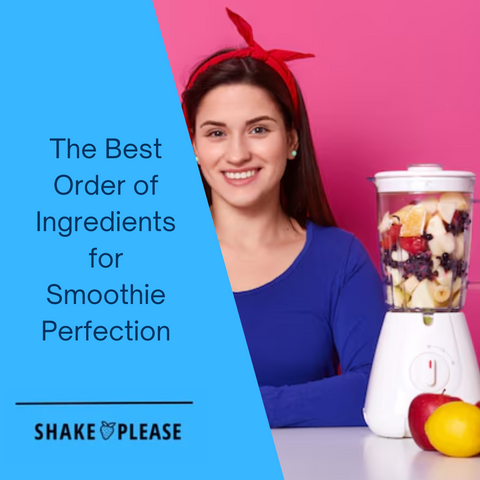
Making the perfect smoothie isn’t just about tossing ingredients into a blender and hoping for the best. The order in which you add them can make all the difference in achieving a more smoothie ingredients full, creamy, and well-balanced drink. Whether you’re after a protein-packed post-workout boost, a refreshing fruit blend, or a nutrient-dense smoothie, understanding how to layer ingredients properly will help you get the best texture and flavor every time.
Building a Smoothie Foundation
-
Start with a liquid base, such as coconut water, milk, or juice, to create a “vortex” that pulls down other ingredients and helps the blender blades move smoothly.
-
Add a small amount of liquid to the blender first to help the blades move more easily through the rest of the ingredients.
-
Use a liquid base that complements the flavors of your other ingredients. If you prefer a very cold smoothie or are using fresh fruit, you can choose to add ice for that extra chill.
Choosing the Right Liquid Base
Choosing the right liquid base is crucial for creating a smooth and creamy smoothie. The liquid base can make or break the texture and consistency of your smoothie. Here are some popular smoothies liquid base options:
-
Milk: Dairy milk, almond milk, coconut milk, and oat milk are popular choices for smoothies. Milk adds a creamy texture and can help to balance out the flavors.
-
Yogurt: Yogurt can add a tangy flavor and a creamy texture to your smoothie. Choose a plain or flavored yogurt that complements your other ingredients.
-
Juice: Juice can add natural sweetness and flavor to your smoothie. However, be mindful of the sugar content and choose juices that are 100% fruit and vegetable juice.
-
Coconut Water: Coconut water is a refreshing and hydrating option for smoothies. It’s low in calories and rich in electrolytes.
-
Tea or Coffee: If you want to add a boost of caffeine to your smoothie, consider using tea or coffee as a liquid base.
When choosing a liquid base, consider the flavor and texture you want to achieve. For example, if you want a sweet and creamy smoothie, milk or yogurt might be a good choice. If you want a refreshing and hydrating smoothie, coconut water could be the way to go.
Adding Nutrients and Boosters
-
Add protein powder, protein powders, or other boosters immediately after the liquid base to ensure they are well-blended and dissolved.
-
Use a small amount of protein powder to avoid making the smoothie too thick.
-
Add other nutrients, such as nut butter or silken tofu, to enhance the flavor and texture of the smoothie.
Is It Healthy To Add Protein Powder To Smoothies?
Nutritional Considerations
When creating a smoothie, it’s essential to consider the nutritional value of the ingredients you’re using. A well-balanced smoothie should include a mix of protein, healthy fats, and complex carbohydrates to keep you full and satisfied.
-
Protein: Adding protein powder or other protein-rich ingredients like Greek yogurt, nuts, or seeds can help to build and repair muscles. Protein powders come in various flavors and types, such as whey, soy, or pea protein, allowing you to customize your smoothie to your dietary preferences.
-
Healthy Fats: Incorporating healthy fats like avocado, nut butter, or seeds can provide sustained energy and support heart health. Nut butters, such as almond or peanut butter, not only add a creamy texture but also enhance the flavor of your smoothie.
-
Complex Carbohydrates: Using frozen fruit, fresh fruit, or leafy greens as the base of your smoothie can provide a boost of vitamins, minerals, and antioxidants. Fresh fruits like bananas, apples, and berries add natural sweetness, while leafy greens like spinach and kale contribute essential nutrients.
-
Fiber: Adding ingredients like chia seeds, flaxseeds, or psyllium husk can help to support digestive health and promote feelings of fullness. These fiber-rich additions can also make your smoothie thicker and more satisfying.
-
Calorie Balance: Be mindful of the calorie content of your smoothie, especially if you’re using high-calorie ingredients like nut butter or coconut water. Aim for a balance of nutrients and calories to support your dietary needs without overloading on any one component.
By considering these nutritional factors, you can create a smoothie that not only tastes great but also provides a boost of nutrients to support your overall health and well-being.
Incorporating Leafy Greens and Fresh Fruit
-
Add leafy greens, such as fresh spinach, kale, or chard, to the blender next to ensure they are evenly incorporated and no stringy fibers are left behind. This step is crucial for achieving a better texture in your smoothie.
-
Use fresh fruit, such as frozen pineapple or berries, to add natural sweetness and flavor to the smoothie.
-
Add other fresh fruits, such as bananas or apples, to enhance the texture and flavor of the smoothie.
Creating a Creamy Smoothie
-
Add soft ingredients, such as yogurt or silken tofu, to the blender to create a creamy and smooth texture.
-
Use a small amount of soft ingredients to avoid making the smoothie too thick.
-
Add other creamy ingredients, such as nut butter or coconut cream, to enhance the flavor and texture of the smoothie.
Adding Frozen Fruit and Ice
-
Add frozen fruit, such as frozen berries or frozen pineapple, to the blender last to create a thick and refreshing smoothie.
-
Use ice to add a thicker consistency to the smoothie and to chill the ingredients.
-
Add other frozen ingredients, such as frozen spinach or frozen kale, to enhance the nutritional value of the smoothie.
Blending and Serving
-
Blend the smoothie ingredients together until they are well-combined and the desired consistency is reached.
-
Taste the smoothie and adjust the ingredients as needed to achieve the perfect flavor and texture.
-
Serve the smoothie immediately and enjoy!
Tips for Customization
-
Experiment with different combinations of ingredients to create unique and delicious smoothie recipes.
-
Use different types of milk or yogurt to change the flavor and texture of the smoothie.
-
Add other ingredients, such as honey or vanilla extract, to enhance the flavor of the smoothie.
Balancing Flavors and Sweetness
Balancing flavors and sweetness is an art when it comes to creating a delicious smoothie. Here are some tips to help you achieve the perfect balance:
-
Start with a Base Flavor: Choose a dominant flavor that you want to feature in your smoothie, such as banana or berries.
-
Add Complementary Flavors: Add other ingredients that complement your base flavor, such as nuts or seeds for added texture and flavor.
-
Balance Sweetness: If you’re using sweet ingredients like fruit or honey, balance them out with ingredients that have a tangy or bitter flavor, like yogurt or spinach.
-
Experiment with Spices: Spices like cinnamon, nutmeg, or ginger can add depth and warmth to your smoothie.
-
Taste as You Go: Taste your smoothie as you’re blending and adjust the flavors and sweetness to your liking.
Discover the Easiest and Healthiest Smoothie Recipes
Looking for tried-and-tested recipes for delicious flavor combos? Check out these:
-
Tropical Bliss – A refreshing mix of pineapple, mango, and coconut milk.
-
Berry Bliss – Frozen mixed berries, Greek yogurt, and honey for a rich and tangy treat.
-
Green Goddess – A creamy blend of spinach, avocado, and banana for a creamy and nutritious smoothie.
-
Strawberry Banana Protein Smoothie – A classic, protein-packed option for a nutritious boost.
-
Chocolate Peanut Butter Banana Protein Smoothie – A rich, indulgent yet healthy choice.
-
Vanilla Berry Protein Smoothie – A smooth, protein-rich blend of berries and vanilla.
By experimenting with different ingredients and adjusting flavors, you can create the perfect smoothie to match your taste and nutritional needs.
Common Mistakes to Avoid
-
Avoid adding too much liquid to the blender, as this can make the smoothie too thin.
-
Don’t add too much protein powder, as this can make the smoothie too thick.
-
Avoid adding frozen ingredients too early, as this can make the smoothie too thick and difficult to blend.
Storage and Shelf Life
Smoothies are best consumed immediately, but if you need to store them, here are some tips:
-
Store in an Airtight Container: Transfer your smoothie to an airtight container, such as a glass jar or a plastic container with a tight-fitting lid.
-
Keep it Cold: Store your smoothie in the refrigerator at a temperature of 40°F (4°C) or below.
-
Consume Within 24 Hours: Smoothies are best consumed within 24 hours of making them. After that, the flavors and texture may start to degrade.
-
Freeze for Later: If you want to make a smoothie ahead of time, consider freezing it. Simply pour the smoothie into an ice cube tray and freeze. When you’re ready to drink it, simply blend the frozen cubes with a little liquid and enjoy.
Some ingredients, even softer ones like frozen fruit and leafy greens, can be stored in the freezer for later use. Simply wash, chop, and freeze them in airtight containers or freezer bags.
Conclusion
A great smoothie is more than just a mix of ingredients—it’s about balance, texture, and flavor. By following a structured approach to layering your ingredients, you can ensure your smoothies are consistently smooth, delicious, and packed with nutrients. Whether you prefer a thick, creamy blend or a light, refreshing drink, experimenting with different combinations will help you find your perfect smoothie recipe. Enjoy the process, and most importantly, enjoy your smoothie!





